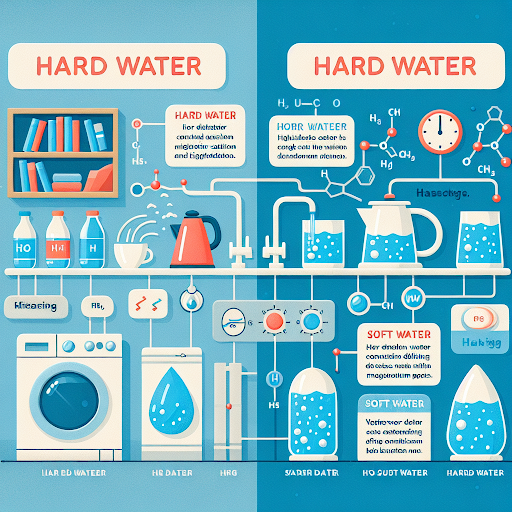PFAS: The “Forever Chemicals” Found in Your Drinking Water
“Forever Chemicals” have been in the news a lot recently, including here in Utah. What are they and why should you care? Here is what you need to know about them and what you can do to protect yourself and your household’s drinking water.
Table of Contents
- What are PFAS Chemicals?
- What are PFOA and PFOS?
- How many PFAS Chemicals are there?
- Why are they called Forever Chemicals?
- Who is responsible for these chemicals being in the environment?
- Who has been exposed to these chemicals?
- How are we exposed to PFAS chemicals?
- What are the health effects of having PFAS in your body?
- Why be concerned about Forever Chemicals?
- Are these chemicals contaminating the water supply here, in Utah?
- What are the health risks of chemicals being present in your drinking water?
- How do EPA limits work?
- What are the EPA limits for “Forever Chemicals” in your Water Supply?
- Have the limits of “Forever Chemicals” (and other contaminants) changed over time?
- What are the health risks associated with having Forever Chemicals in the water in your house?
- Are all chemicals that can contaminate drinking water regulated by the EPA?
- What other substances can be present in your water?
- What is being done to protect the public from the PFAS contamination crisis?
- How can I know if these chemicals are in my tap water?
- What else can you do to protect yourself and your family?
What are PFAS Chemicals?
In 1938, a chemical compound was discovered that was patented as Teflon. It was patented first by DuPont and then 3M became its primary manufacturer. It is a synthetic fluorinated chemical called polytetrafluoroethylene that was the first known PFAS (per- and polyfluoroalkyl substances). PFAS are a group of these types of manmade chemicals and started being used extensively in the mid 19th century. The commonality between this group of manmade chemicals is that they bond carbon and fluoride molecules together. The attraction to using them was because of their water-resistant type properties. They are used to make things water proof, grease proof, stick-proof or stain resistant and are all around us. Some examples of places they are used include:
- Teflon pans
- Tape
- Car seats
- Mattresses
- Water or Stain proof Clothing, Furniture and Rugs
- Outdoor gear like tents, backpacks, etc.
- Umbrellas
- Dental floss, mascara, some make-up
- Artificial turf
- PPE
- Pizza boxes, food wrappers, microwave popcorn bags and other food packaging
- Commercial Applications and Building Products
- Firefighting Chemicals
Because of their decades of heavy use, they have contaminated the soil throughout the country. The soil has been shown to be more concentrated around manufacturing facilities (as documented in the movie “ The Devil We Know “) and also through disposal post-consumer. In turn, they have seeped from soil to the water and are found inside of most people’s blood.
The bond formed is extremely strong and does not break down quickly in nature or in the human body. This is why they have been dubbed “forever chemicals.
Unfortunately, PFAS are essentially impossible to avoid. Hundreds of products that you use every day are made using these toxic chemicals.
What are PFOA and PFOS?
PFOA (perfluorooctanoic acid) and PFOS (perfluorooctane sulfonate) are the oldest studied PFAS chemicals. The EPA no longer allows them to be produced in the US but still allows them to be used in products manufactured in different countries and then imported.
They have been shown to be harmful, even at very low doses. Additionally, the more they are studied, the worse we find out they are. For example, in 2016, the EPA set out guidelines saying that drinking water was safe at levels below 70 parts per trillion of these two chemicals. However, in 2022, they revised the guidelines to essentially say that there are health risks even down to near-zero levels.
They are the only two PFAS that are currently regulated and the majority of the research that has been done about PFAS are around these two compounds.
How many PFAS Chemicals are there?
There are thousands of PFAS Chemicals. Most PFAS chemicals are not tested for or regulated by the EPA but here is a list of all the ones they currently recognize. At the time of this writing, there are more than 15,000. (That sentence will wind up dating the article 🙂 If you research other articles that have been written, you can tell how recent it is by what number they reference in regards to this website. Not only are there thousands but the number is growing at a quick rate. All PFAS chemicals are manmade. As they are used in more and more applications, there are more and more variations of them.
Other than PFOA and PFOS, none of them are regulated. There has been a recent proposal by the EPA to impose limits on 6 PFAS chemicals in drinking water. In addition to PFOA and PFOS, it would also limit levels of PFBS, PFNA, PFHxS and GenX. Less than 100 have been publicly studied or measured as potential contaminants in water in regards to their presence or potential health concerns. The rest (the vast majority) are not really talked about much at all but are potentially just as dangerous.
The discovery of health risks with PFAS chemicals seem to be following a similar trajectory, although it is very early to tell. The first ones were made in the 1940’s. By the 1950’s and 1960’s, they knew that they caused cancer in rats (those were the first tests they did). As they did (and are doing) more and more tests, they kept finding out that they are very bad for human health which is why they were banned.
The alternate that they are using now, is a shorter string chemical and was supposedly going to be safer. The first tests they did were on rats and, you guessed it, they caused cancer. Much is unknown about their health risks for humans as there hasn’t been time to study it yet. To me, it looks like they are on the same trajectory as PFOA and PFAS and that is not good news.
Why are they called Forever Chemicals?
The simple answer is that they are nearly indestructible. They last for thousands of years. The PFAS chemicals that go into your body will not be destroyed in a meaningful way during your life time.
The good news is that they are present in urine and you lose some of them that way. What that means is that if you can figure out a way to limit their intake, you can reduce the levels in your body over time as you literally pee them away.
On a side note, we really should be figuring out how to get rid of them permanently as they do not break down naturally (technically they do really, really slowly but certainly not as fast as they are being produced) and, once we get rid of them, they are reabsorbed into the soil from the waste water treatment plant or landfill that they end up in. From there, they go to the water and then back into us. There is starting to be some research in how to split the carbon from the fluoride so that they can decompose in a more reasonable timeline but very little has been done in that regard. This conversation is really outside of the scope of this article but i wanted to mention that it is a discussion worth having.
Who is responsible for these chemicals being in the environment?
At one time, the creation of these chemicals was called a “ consumer miracle of modern chemistry.” Even though some knew of their danger, they were (and still are) heavily incorporated into common use. As consumers, everyone loved how they worked so their use took off.
Really the manufacturers should take the majority of the blame, although they didn’t understand the health indications originally. Today, we all share in the blame unless we don’t buy any products that have them (which is unlikely). It is a big problem that needs a big solution.
As far as how they get from the manufacturing into our bodies, it is mostly through what we eat and drink. During the production of these chemicals, and their incorporation into products, waste is created. After consumers use them, they also end up being thrown away. Eventually, they all end up in landfills or waste water treatment plants. From there, they are absorbed into the soil and then into the water supply. From the water supply, they end up back in use and the cycle continues.
Who has been exposed to these chemicals?
Everyone.
The most testing for these chemical sites has been around manufacturing and industrial facilities along with military bases that used these chemicals extensively. The presence of these chemicals has been heavy in both the soil and water around these facilities. We have also learned that because they are basically indestructible, their ability to travel is high as well. Through natural weather patterns they have travelled around the world and, as testing has expanded geographically, have been found basically everywhere anyone has looked.
According to this study , more than 200 million Americans could have PFAS in their drinking water and according to this study, more than 98% of people tested had them in their blood.
There are two additional challenges to this question. First, the testing has gotten better. In the early 2000s, when they started testing, you can find studies saying things like “45% of the nation’s tap water has PFAS.” As our ability to test has gotten better, however, that number keeps going up. Second, there is not a general test so they are only testing for the specified compounds (such as PFOA and PFOS). Until recently, only those 2 were tested for. More recently, the EPA starting testing for 32 different PFAS and now they know that a lot of our water is contaminated with those as well. As mentioned earlier, there are thousands of PFAS. My assumption is that if we were to test for them, we would find them as well.
How are we exposed to PFAS chemicals?
Overtime, PFAS can leak into the soil, water and air. People are then exposed to these chemicals through normal, everyday activities by coming into contact with them.
The main way we are exposed to forever chemicals is through what we eat and drink. Forever chemicals enter the environment from four main places: industrial sites, fire response and training sites, landfills, and wastewater treatment centers.
These chemicals became well known in relation to their use in factories, military bases and landfills so, in the past, people may have thought that as long as they didn’t live near one of these facilities they were save. Unfortunately, because of how long these chemicals last and how they are able to travel, they be found spread throughout the country – even in places without an obvious source. In fact, studies have been done in remote areas and have found the PFAS present in wildlife in very remote locations.
Children are especially at risks because of a couple of factors. First, they drink and breath a large amount compared to their body weight so the chemicals accumulate in their bodies more quickly. Second, because they are so close to the ground and put objects and their hands into their mouths so often, they are further exposed to chemicals more frequently. Additionally, children can start getting these chemicals passed to them while still in the womb and get them through breast milk or the water used to make their formula.
What are the health effects of having PFAS in your body?
PFAS chemicals weren’t widely studied until the early 2000s. Prior to that, specific companies such as 3M or DuPont had internal research but did not disclose it publicly.
Even very small doses of PFAS present in the body have been linked to cancer, immune, reproductive system, and other health problems. Studies have linked these chemicals to many health challenges such as:
- Cancer
- Reproductive Problems (including lower birth weight)
- Weakened Immunity
- Endocrine/Hormone Disruption
- Increased Cholesterol
- Lower Birth Weight
- Increased Weight Gain in Both Children and Adults
- Reduced Vaccine Efficacy
Scientists are still learning about the effects that PFAS has on the human body, but none of what they are learning is good news. Basically, there is nothing positive that happens (from a health perspective) and plenty of negative.
Why be concerned about Forever Chemicals?
Well founded concerns about forever chemicals come from the following facts:
- PFAS are used in hundreds of commonly used products.
- They can be found in the soil, the water and even the air.
- These chemicals basically last forever.
- Because they last so long, they can make their way into our soil and water.
- There are more of these types chemicals being introduced into our products all the time.
- Most PFAS are not tested for.
- Whatever PFAS are tested for are found almost everywhere.
- The vast majority of people that have been tested for them have levels present in their blood.
- Because these chemicals are so persistent, they can accumulate in a person and the levels can increase over time.
- There are health risks associated with the chemicals – and are toxic even at very low levels.
Additionally, there are thousands of PFAS. Most of them have not been studied to see if there are health risks associated with them but all of them that have been studied have been found to be harmful. Also, wherever we look for them, we find them. If an area has not been shown to have PFAS, it is likely that it just hasn’t been tested yet.
Are these chemicals contaminating the water supply here, in Utah?
Yes. Most of the testing that is available for research has been done around the military sites and the contamination level is high. All of the testing that I have seen has had it present at some level.
As mentioned earlier, it has spread and it is possible to find it everywhere.
Even in rural mountain areas (picture Park City) there is reason to have specific concern. The foam that was used to fight fires (and train fire fighters) was made with PFAS chemicals. Because they last forever, even if there was a fire decades ago, it would have introduced these chemicals into the local environment.
In rural farming areas (picture Heber before the recent housing boom) some of the fertilizer that has been used also contained these chemicals.
What if you have a well? It is no different. It still absorbs the water that has potentially been exposed to these harmful chemicals.
What are the health risks of chemicals being present in your drinking water?
Eating and drinking are the primary ways that the forever chemicals get inside of your body. As you drink it, it builds up in your body (called bioaccumulation) and because they last so long, even if you are ingesting it in very small doses, it will still build up in your body tissue.
Drinking water is a particular concern because of the volume that is consumed so regularly. When you add to this the fact that PFAS can be toxic in very small doses, it is a dangerous combination. One of the main instigators of the health risks mentioned throughout this article is, unfortunately, your drinking water.
You can see the health risks of PFAS (forever chemicals) here. The health risks associates with other chemicals would be an even longer list.
How do EPA limits work?
The EPA sets their limits based on a variety of factor including:
- Known research
- Current levels
- Time and cost to reduce current levels
- Pressure and advocation of various groups
When considering how to best address these forever chemicals, all of these factors are at play. The research keeps showing how bad these are for your health and the EPA is currently researching to find out what the levels are currently at. It is likely that they will propose a way to gradually bring the levels down and have their regulations become more stringent over time.
Different advocacy groups are involved in the discussion. Local water suppliers are asking how to pay for the changes. Advocacy groups for poorer communities are wanting to make sure that the costs don’t get passed on to people that can’t afford it. Other groups want them all gone today – regardless of the cost – because of the health risks. Industry groups are wanting to keep using the chemicals in their products, and the list goes on and on. The EPA’s job is to sort through all these concerns and try to formulate a plan that is basically a big compromise.
Once new guidelines are set, there is typically a period (of several years) in which they are to be enacted.
For all of these reasons, the EPA’s reaction time is notoriously slow. If you are concerned about the health risks in you and your family, waiting for the government regulations to solve the problems will likely not happen quickly enough to satisfy you. Additionally, what the EPA deems as legal or even recommended may still be higher than what you would consider to be an acceptable level.
What are the EPA limits for “Forever Chemicals” in your Water Supply?
PFOA and PFOS in drinking water is currently limited at 70ppt (parts per trillion). None of the other PFAS chemicals are regulated.
These are “standards” and are not legally enforceable. They are basically guidelines that water providers are asked to adhere to voluntarily.
Have the limits of “Forever Chemicals” (and other contaminants) changed over time?
Yes. The EPA regularly changes the amount of chemicals allowed. As new research comes out, the EPA guidelines are updated. However, the guidelines will typically lag our current knowledge. For example, the EPA considers tap water to be safe if the dosage of PFOA and PFOS are less than 70 ppt. However, new research shows that even at levels of 1 ppt, there are increased health risks.
Additionally, some of the substances that are banned are replaced with alternatives that have not been well tested and have not had encouraging results when they were tested. For example, PFOA and PFAS have been banned but the chemicals (still PFAS chemicals) they use as replacements may not be much better (see here for an article discussing these two specific chemicals and their replacements). Evidence is emerging that shows that these replacement chemicals persist in the environment, bioaccumulate in our bodies, and have could have a similar health risk profile to the chemicals being replaced.
It is extremely likely that the EPA will continue to adjust their guidelines.
What are the health risks associated with having Forever Chemicals in the water in your house?
PFAS are extremely toxic. Even at the EPA’s current recommendations (which are likely to become more strict) you can see that this is the case.
PFOA and PFOS are regulated at 70 parts-per-trillion (ppt) in drinking water. That is equivalent to .07 parts-per-billion (ppb). By comparison, cities must only take action on lead if it exceeds 15 ppb. That means that, according to the EPA’s current guidelines, lead can be present at levels 200x larger than PFAS and no action needs to be taken.
The takeaway is that if you would be concerned about lead being in your water, you should be very concerned about PFAS being there.
Are all chemicals that can contaminate drinking water regulated by the EPA?
No. You can see a list of currently regulated contaminants and their allowable levels here. There are many substances that people find concerning not on that list. In fact, you can see a list of contaminants that they are monitoring and not regulating on their website, here and here. Notably, PFAS are not on their regulated list – they are only monitoring it.
In addition to PFAS, these lists include:
- Heavy metals (such as boron, mercury, lead, radium, uranium, etc.)
- Various acids (such as dacthal, etc.)
- Controversial additives such as fluoride
and many others,
Waiting for the EPA to regulate a chemical can put your family at risk. Prior to the EPA regulating a substance, they have to become aware of it, then there needs to be studies confirming the health risks, then there need to be studies showing how much is in the water supply. Following all that, they will typically regulate the chemicals at a level still higher than many people feel is safe. Over time, they can then lower the levels as the water providers meet the currently regulated levels.
All this can take decades. The entire time your household could be consuming chemicals that can put your health at risk.
What other substances can be present in your water?
Almost anything you can think of can be present in your water. In addition to the list above, this can include:
- TDS (total dissolved solids)
- Calcium, Magnesium and other metals that cause hard water
- Viruses
- Bacteria
- Chlorine, Chloramine and other substances used to treat water
- Ammonia
- Aluminum
and many others.
Water passes through many stages before it gets to your house. In each step from it’s collection to its treatment and even through the pipes on its way to you, there is the possibility of coming into contact, and absorbing, dangerous contaminates that can end up in your body.
What is being done to protect the public from the PFAS contamination crisis?
The EPA has not set a federally enforceable standard for PFAS in drinking water. They have set a standard for limits for any PFAS in tap water. However, the limits are still many times higher than researchers consider safe. Similarly, the FDA and Pentagon have generally been slow to act to change the chemical’s continued use and the cleanup of these chemicals. In 2019, Congress to limit the military’s use of PFAS chemicals and to expand their monitoring. In 2021, the EPA released its PFAS strategic roadmap to increase research and pressure on manufacturers to limit PFAS use. Additionally, many state governments have enacted further legislation to deal with these problems. (Here is a link to Utah’s only bill in this matter which deals with schools.) To sum up, the government’s response has been slow and, in many people’s opinion, underwhelming. Additionally, manufacturers are not required to notify customers that they are using them.
Although the EPA is doing many things to help combat this crisis, relying entirely on their regulations and enforcement is too slow and not comprehensive enough for many people. It is important to take the safety of your water seriously and to take measures that ensure that you are not being exposed to these health risks on your own.
How can I know if these chemicals are in my tap water?
They probably are. PFAS has been found in the tap water in all 50 states. Here is a map that us updated regularly and shows the results of reported testing of specific sites and municipalities. Reporting testing is not complete and there are many areas that have not been tested at all.
PFAS are likely present in well water as well. Because the chemicals are ubiquitous and can be absorbed by soil, it is likely that they are found at some level in almost all water sources. Additionally, many other substances and chemicals are likely present in your water.
At Water Science, we can come out and test to know exactly what is in your water. We have invested in expensive equipment that, in many cases, allows us to perform the tests while we are at your home and provide you with the results almost instantly. Depending on the situation, we also have partnerships with labs where we can send your water to do additional testing.
What else can you do to protect yourself and your family?
The good news is that levels of PFAS in your body can be reduced over time. In addition to being found in your blood, they can also be tested for in urine. What that means is that while the chemicals themselves last forever, if the amount of exposure that you have is reduced, the amount in your body will gradually be reduced as well.
One of the best ways to reduce your exposure to these chemicals is by addressing your drinking water. There are water filters that can remove PFAS.
Water Science can help design, install and maintain a filtration solution to make your water safe again. Realistically, water should be water – just H20. None of these substances should be in there.
Normally a multi-stage system is best for removing unwanted contaminants.
A recent study has shown that reverse osmosis systems can almost completely remove PFAS chemicals and make your water safe again. Additional guidelines from the EPA show that specific types of filters can be more effective against different contaminants – bot no filter is effective against everything. For example, carbon filters (when properly maintained) can be 100% effective against removing PFOA and PFOS but are not effective against removing the PFAS that have replaced them. Essentially, different filters are better at removing different types of impurities from your water. By having an expert design a custom system based on the testing results at your house, we can design and install a system that can be effective at removing the various contaminants and returning your water to being just water.
Water filtration can be beneficial in these situations:
- Your tap water has been tested and is higher than the allowable limits but the city is not treating it yet
- Your tap water is being treated by the city to reduce the contaminants to a legal level but you want it to be lower
- There are levels of contaminants in your water that are high enough to be concerning but below the level where the city will treat it
Regardless of your situation, we can design a water system that can make your water pure again and minimize the exposure of harmful chemicals to your household from your water.
If you have further questions or would like to schedule for one of our experts to come out, contact us at the number above or by filling out a contact form.
The post PFAS: The “Forever Chemicals” Found in Your Drinking Water appeared first on Water Science.











